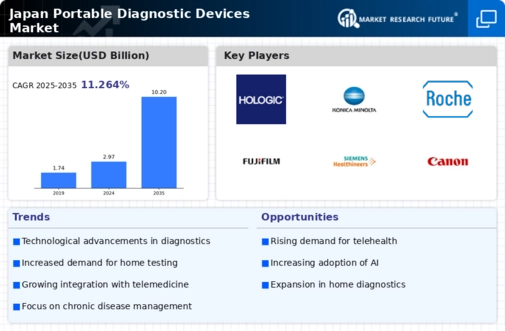Advancements in Wireless Technology
Advancements in wireless technology are playing a crucial role in shaping the portable diagnostic-devices market. The proliferation of mobile connectivity and the Internet of Things (IoT) has enabled the development of sophisticated diagnostic devices that can transmit data seamlessly to healthcare providers. This capability enhances remote monitoring and telehealth services, which are becoming increasingly popular in Japan. The market for wireless portable diagnostic devices is projected to grow by 20% over the next five years, driven by the demand for real-time health data sharing. As healthcare systems embrace digital transformation, the integration of wireless technology into portable diagnostic devices is likely to enhance patient engagement and improve overall healthcare delivery.
Growing Focus on Preventive Healthcare
The shift towards preventive healthcare in Japan is significantly influencing the portable diagnostic-devices market. With rising healthcare costs and an emphasis on early detection of diseases, there is a growing awareness among consumers about the importance of regular health monitoring. This trend is reflected in the increasing sales of portable diagnostic devices, which allow individuals to track their health metrics conveniently. Market data indicates that the preventive healthcare segment is expected to grow by 12% annually, further propelling the demand for portable diagnostic devices. As more people prioritize health and wellness, the portable diagnostic-devices market is likely to expand, offering a range of products designed for proactive health management.
Integration of Artificial Intelligence
The integration of artificial intelligence (AI) into portable diagnostic devices is emerging as a key driver in Japan. AI technologies enhance the accuracy and efficiency of diagnostics, enabling quicker decision-making in clinical settings. For instance, AI algorithms can analyze data from portable devices to provide real-time insights, which is crucial for timely interventions. The portable diagnostic-devices market is witnessing a surge in AI-enabled products, with a projected increase in market value by 15% annually over the next five years. This technological advancement not only improves patient outcomes but also streamlines healthcare processes, making it a vital component of the evolving healthcare landscape in Japan. As healthcare providers increasingly adopt AI solutions, the demand for innovative portable diagnostic devices is expected to rise significantly.
Rising Demand for Home Healthcare Solutions
The increasing preference for home healthcare solutions in Japan is driving the portable diagnostic-devices market. As patients seek convenience and accessibility, the demand for devices that can be used at home is surging. This trend is particularly evident among the elderly population, who often require regular monitoring of chronic conditions. According to recent data, the home healthcare market in Japan is projected to grow at a CAGR of 8.5% from 2025 to 2030. This growth is likely to stimulate innovation in portable diagnostic devices, as manufacturers aim to meet the needs of this expanding market segment. the portable diagnostic-devices market will benefit from this shift towards home-based care., as more individuals opt for devices that facilitate self-monitoring and reduce the need for frequent hospital visits.
Increased Investment in Healthcare Innovation
Increased investment in healthcare innovation is a significant driver of the portable diagnostic-devices market in Japan. The government and private sector are channeling funds into research and development to foster technological advancements in medical devices. This focus on innovation is expected to yield new portable diagnostic solutions that cater to the evolving needs of healthcare providers and patients alike. Recent reports indicate that investment in healthcare technology is set to rise by 25% in the coming years, which could lead to breakthroughs in portable diagnostic devices. As a result, the portable diagnostic-devices market is likely to experience a surge in new product launches and enhancements, further solidifying its position in the healthcare ecosystem.




















Leave a Comment